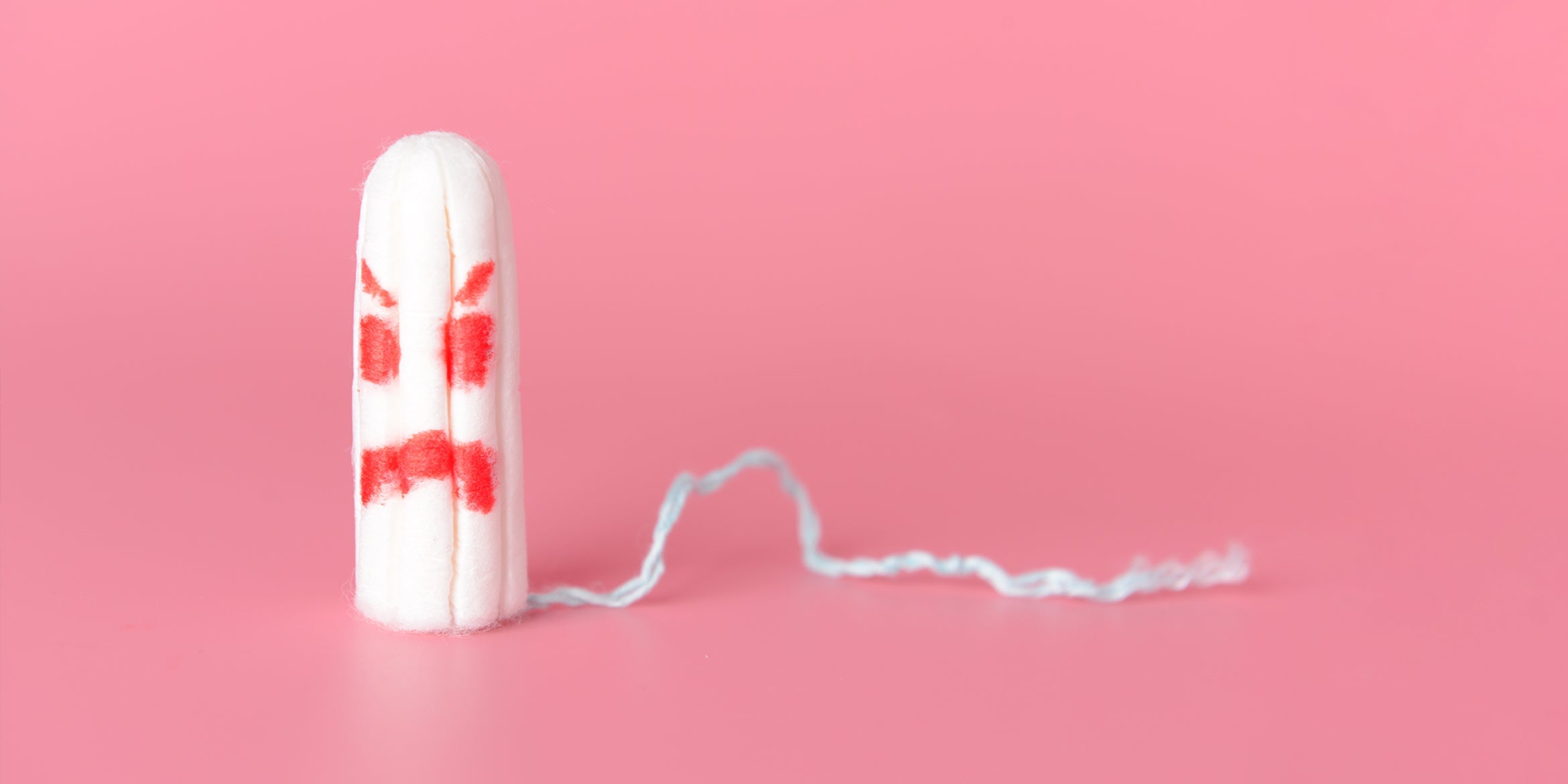Pain and discomfort are the most common reasons people don’t use tampons.
It’s time to ditch the discomfort and manage your period your way — with the help of TINA.
Tampons don’t work for everyone because the one-size-fits-all version was invented over 90 years ago. The tampons we see today have seen very few design changes and weren't made to work for you.1
That can make for a pretty uncomfortable experience every month. Tampons are intended to be a period solution, not a painful problem. Everyone is different, but you should not feel the tampon once it’s in.
We don’t want you to feel discouraged – we get a lot of questions about tampons causing pain or discomfort from the TINA community. Let’s troubleshoot and note when it might be time to see a doctor.
If we haven’t answered your question here, reach out to us and ask! We’re here to be a community resource.
Why does my tampon hurt?
This is a great place to start because it should not hurt when you wear a tampon if you’ve put it in properly. If it does, there can be several causes.
If your angle is off when you put it in or it’s not inserted deeply enough, your flow is light or you have an infection, tampons can be uncomfortable or painful. Remember that the angle of your uterus is unique, so it may take some time to get used to how you need to insert tampons to wear them comfortably.
It’s important to listen to your body, make adjustments (for example, try different tampon brands or sizes) or see a doctor if necessary.
TINA tips: As you insert the tampon (with clean hands!), make sure you aim and angle it downwards, toward the base of your spine. The string should be hanging outside of your vagina so you can remove it easily.
Tampon hurts when I walk or sit!
Tampon pain from walking or sitting can happen if you haven’t inserted the tampon deeply enough. When you put it in, it should go past the nerve endings of your pelvic floor muscles.
If you’ve inserted the tampon to the correct depth, you won’t feel it when you’re active. When you don't, your body lets you know by using your vaginal muscles to push out the tampon.
TINA tip: Be patient and listen to your body if you’re in pain as you move or sit. Try tampons with different absorbances to find the most comfortable fit. A tampon insertion aid can help you get the correct depth to be pain-free when you’re active.
I feel sharp pain wearing tampons.
You may feel a sharp pain as you wear tampons if you have an underlying medical problem, an infection (anything from a sexually transmitted disease to a urinary tract infection).3
Do not force the tampon in. Your body is trying to let you know it’s having a problem.
TINA tip: If you feel a sharp pain when you wear tampons, you may have a medical condition that needs to be treated. Temporarily switch to a pad or pantiliner until you can see your doctor to find out more.
Do tampons cause cramps?
No – a hormone named prostaglandin is the culprit here, not tampons!
In fact, cramps don’t occur in your vagina, where you insert the tampon. Instead, cramps occur deeper inside the body, in the uterus. They’re a movement of the uterine muscles and blood vessels to move the flow out of your body.
Sometimes people attribute menstrual cramps to tampon pain because prostaglandins are at their highest level during the first day of menstruation.
Just as your period lightens in the latter days of your cycle, so do the levels of prostaglandins. This means your cramps improve as well!
Tampons might intensify the pain of the following conditions:
- Urinary tract infections.
- Endometriosis.
- Vaginismus.
TINA tip: Tampons don’t cause cramps, but if you’re feeling cramping pain that doesn’t lessen as your cycle progresses, speak with your doctor.
Will tampons hurt with endometriosis?
They can, but the tampon pain associated with endometriosis tends to be similar to endometriosis dyspareunia, a term used to describe pain during sex. With endometriosis, a tampon can cause a heavy pain felt deep in the abdomen, or cramping.
Sometimes the tampon pain related to endometriosis also can cause your vaginal muscles to tense, causing a sharp pain at the entrance of the vagina when inserting or removing a tampon.
TINA tip: If you have endometriosis, speak with your doctor about which options for managing your period might be most comfortable. Speak up about how you’re feeling so your doctor can help you determine which type of pain relief options might work for you.
My tampon feels dry!
That can be as simple as a lighter flow, making using the tampon uncomfortable. You may feel discomfort–almost a type of friction–when you wear tampons because you’re dry.
The fabric of the tampon also can be a factor. Tampons soak up moisture, making them more comfortable when you’re better lubricated.
Vaginal dryness also can be a product of changes in your body: stress, a hormonal shift, or a change in medication.2 If you notice you’re chronically dry, speak with your doctor.
TINA tip: If you’ve switched to a lighter absorbance tampon and still feel pain and dryness, try a panty liner (pantiliner) or small pad instead when your flow is light. A safe vaginal lubricant also can make it easier to put in tampons. Your doctor can let you know which ones might help.
Remember: If your tampon feels uncomfortable…
- Listen to your body: You should not feel the tampon once it’s in properly.
- Your body is unique: The angle of your uterus may not be “standard,” so it may take time to learn to put it in at the correct angle.
- Try again: If you feel the tampon as you move, you may need to insert it deeper.
- Go with your flow: Try different size tampons as your flow changes. If it’s light, you may need extra lubrication to insert and wear it comfortably.
- Be patient and relaxed: Taking your time is a big help in using tampons, especially if you’re in the trial-and-error stage and they’re new to you.
- Speak with your doctor: Keep track of the type and location of your pain so you can describe it to your doctor and figure out the next best steps for you.
- Borowski, Ann, "Are American women turning to reusable and greener menstrual products due to health and environmental pollution concerns?" (2011). Thesis. Rochester Institute of Technology. [cited 6 January 2023] Accessed from: https://scholarworks.rit.edu/cgi/viewcontent.cgi?referer=&httpsredir=1&article=1547&context=theses
- Partin, Alan. Surgical Management of Differences of Sexual Differentiation and Cloacal and Anorectal Malformations. [cited 6 January 2023] Accessed from: https://www.sciencedirect.com/topics/medicine-and-dentistry/vagina
- Why do tampons go sideways? Supported Moms. 23 May 2016. [cited 6 January 2023] Accessed from: https://supportedmums.com/why-do-tampons-go-sideways/#:~:text=the%20cervix%20deflects%20the%20tampon%20sideways&text=The%20cervix%20is%20the%20size,accident%20when%20inserting%20a%20tampon
- Langdale, Tara. When Your Tampon Won't Go In, What’s Going on? VuVa Tech. 02 Jan 2020. [cited 2022 June 29] Accessed from: https://www.vuvatech.com/blogs/care/tampon-wont-go-in
- Pelvic floor muscles. Continence Foundation of Australia. 27 May 2022. [cited 6 January 2023] Accessed from: https://www.continence.org.au/about-continence/continence-health/pelvic-floor
- TAMPS. How to avoid tampon leaks? [cited 6 January 2023] Accessed from: https://tampax.co.uk/en-gb/tampon-truths/how-to-avoid-tampon-leaks/



